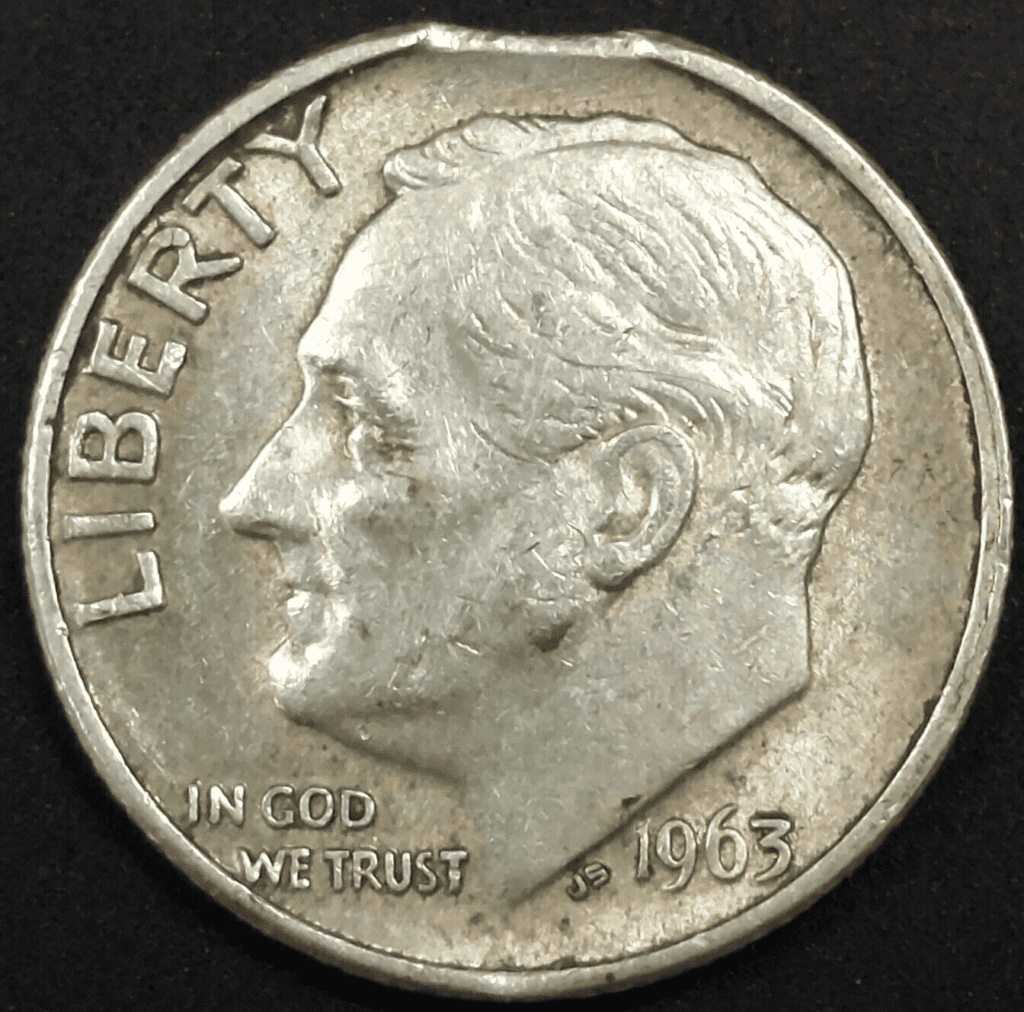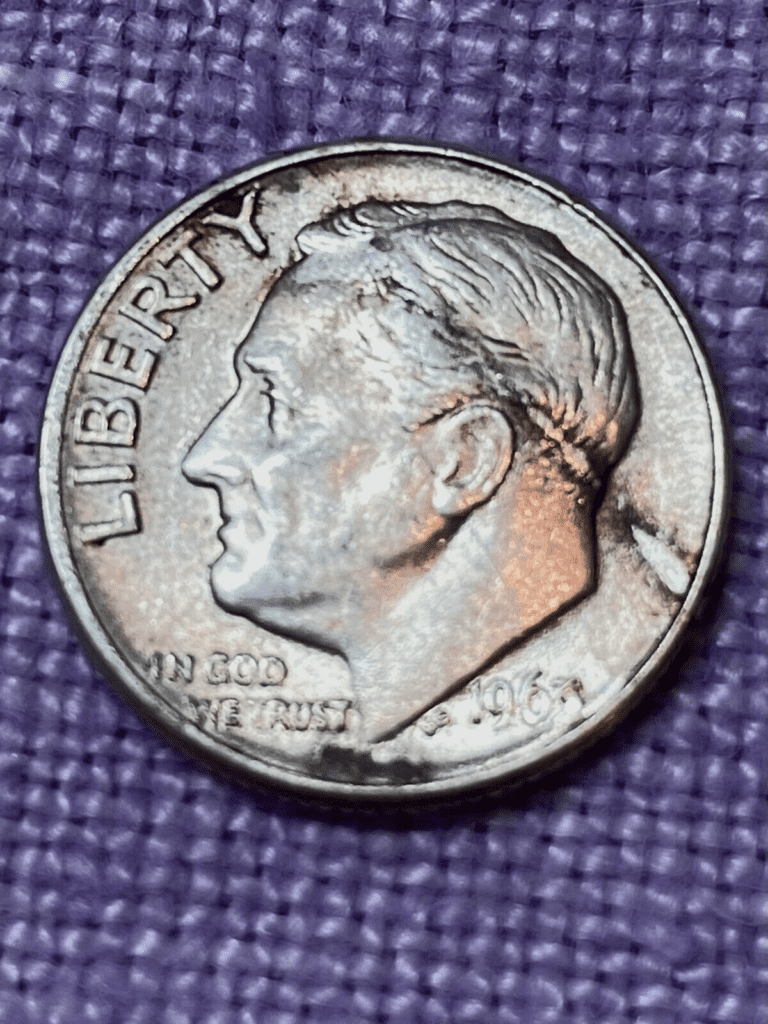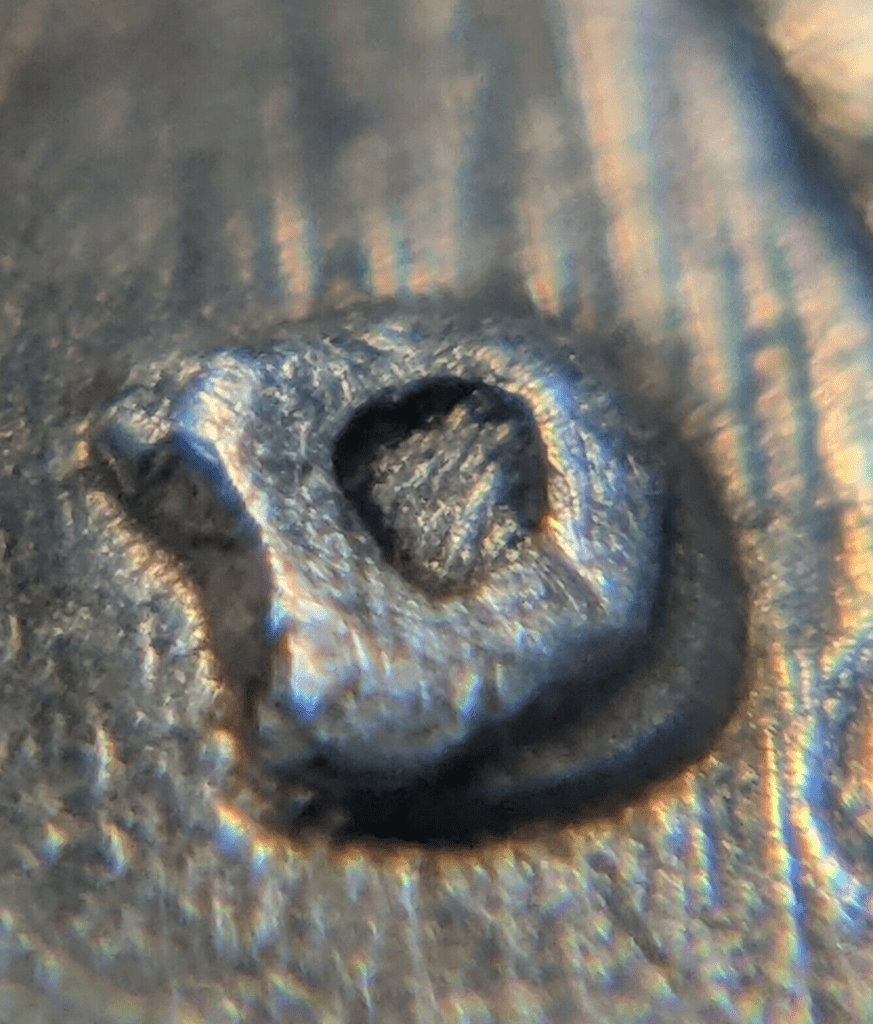What Is the 1963 Roosevelt Dime Made Of?
The 1963 Roosevelt dime is composed of 90% silver and 10% copper. The Roosevelt dime was first struck in 1946, and from that year to 1964, it was made of silver and copper. Then, starting from 1964 to the present, silver was removed, and the dime was made of base metals.
Although the U.S. Mint stopped producing standard silver Roosevelt dimes, they still created them from 1992 to 2018, but only for collectors and not for general circulation.
To give you more idea, here are the specifications of the 1965 Roosevelt dime:
- Value – 10 cents
- Diameter – 17.91 mm
- Mass – 2.50 g
- Edge – reeded
Franklin Delano Roosevelt often referred to as FDR, was the 32nd president of the United States. He died in 1945, and in the same year, Congress authorized his face to appear in the 10-cent coin. Thus, in 1946, the first Roosevelt dime was issued, replacing the mercury dime.
At that time, John Sinnock was the Chief Engraver of the U.S. Mint. He immediately created his new design for the dime. However, he repeatedly created different versions until the Commission of Fine Arts approved the final version. From there, the design of Sinnock remained essentially the same to this day.

photo source: USA Coin Book
The obverse features Franklin Roosevelt, whose image is facing left. The inscriptions include the following:
- LIBERTY
- IN GOD WE TRUST
- 1963
- Designer’s initials (JS)
On the reverse side, you’ll find the liberty torch in the center. You’ll also see images of an olive branch, which represents peace, and an oak branch, which symbolizes independence and strength.
The inscriptions include the following:
- UNITED STATES oF AMERICA
- E PLURIBUS UNUM
- ONE DIME
Choosing FDR for the dime is quite interesting. As you may have remembered, FDR was instrumental in founding the National Foundation for Infantile Paralysis in 1938. Later, this foundation was called the March of Dimes. FDR himself suffered from polio. So, it was just fitting for him to be on the dime coin, which has the same name as the foundation he started.
1963 Roosevelt Dime Varieties
The 1963 Roosevelt dime has at least three varieties. These are the 1963-D, 1863-P, and 1963 Proof Roosevelt dimes. Aside from these standard-issued coins, some error coins give rise to a new variety. At the end of 1963, there were more than 548,202,000 10-cent coins struck by the U.S. Mint.
To learn more, here are the 1963 Roosevelt Dime Varieties:
1963 D Roosevelt Dime
Year of minting: 1963
Mint Mark: D
Place of minting: Denver
Quantity produced: 421,476,530
Face Value: $0.10 (one cent)
Price: $0.10 to $14 (or more)
Mass: 2.50 grams
Edge: Reeded
Designer: John Sinnock
Composition: 90% Silver, 10% Copper
Diameter: 17.91 mm
Thickness: 1.35 mm

photo source: PCGS
The Denver Mint produced the most number of Roosevelt dimes in 1963. There were more than 421 million 1963 D Roosevelt dime coins produced. You can sell these coins from $0.10 to $14, depending on the rarity and condition of the coin.
The 1963 D Roosevelt 10-cent coin is fairly common even for those coins with a grade of MS-66. However, MS-67 1963 D dimes are scarce, and they become rarer when they reach a grade of MS-68.
1963 P Roosevelt Dime
Year of minting: 1963
Mint Mark: No mint mark
Place of minting: Philadelphia
Quantity produced: 123,650,000
Face Value: $0.10 (one cent)
Price: $0.10 to $31 (or more)
Mass: 2.50 grams
Edge: Reeded
Designer: John Sinnock
Composition: 90% Silver, 10% Copper
Diameter: 17.91 mm
Thickness: 1.35 mm

photo source: PCGS
The Philadelphia Mint produced 123,650,000 Roosevelt dimes in 1963. You can sell these coins from $0.10 to $31 or even more, especially when you sell them in the open market.
Since there are more than 120 million 1963 P Roosevelt 10-cent coins, you should be able to find them easily. However, 1963 P dimes in gem condition are rare, especially if it is with Full Bands.
1963 P Roosevelt Dime (Proof)
Year of minting: 1963
Mint Mark: No mint mark
Place of minting: Philadelphia
Quantity produced: 3,075,645
Face Value: $0.10 (one cent)
Price: $0.10 to $11 (or more)
Mass: 2.50 grams
Edge: Reeded
Designer: John Sinnock
Composition: 90% Silver, 10% Copper
Diameter: 17.91 mm
Thickness: 1.35 mm

photo source: PCGS
Aside from the standard coins, the Philadelphia Mint also produced more than 3 million proof 1963 dime coins. Proof coins are made for collectors. They are shinier and more detailed. Because it takes more time and effort to produce proof coins, they are the fewest variety in the 1963 dime series.
The price starts at around $1 to $11. Again, the price may still be higher when you have a proof coin that is still in good condition.
List of 1963 Roosevelt Dime Errors
As mentioned, there are more than 548 million 1963 Roosevelt dimes. So, it should not be surprising to see some of these coins having minting errors.
There are different reasons that error coins happen. One primary reason is the failure of the minting equipment to function correctly. For example, the die can break, the alignment between the die and planchet may not be correct, the die may hit the coin more than once, and others. Aside from that, human errors also come into play.
For the 1963 Roosevelt dime, perhaps, the most common error is the doubled die reverse (DDR) error in their poof coin issues. This happens when the die hits the planchet twice, which causes a doubling of some of the engraved elements.
To give you a better idea, here’s an image for you to look into:

photo source: USA Coin Book
The error may not be too noticeable, but with a trained eye, you can see the error. Look closely at the word “UNITED STATES OF AMERICA.” You should see a doubling of the words. Even the motto, “E PLURIBUS UNUM,” has a doubling, too, although it’s not that easy to spot.
Coins with DDR errors are known to be more expensive than ordinary coins. The more prominent the error is, the higher its value.
Sometimes, an error happens during the cutting of the planchet. Here’s an example of a 1963 dime with a clipped planchet:

photo source: eBay
As you may remember, the 1963 dime is made of silver, but it is clad with copper. There are times when the cladding is improperly done. This makes some portions of the coin to be discolored like this one:

photo source: eBay
Another error is called the repunched mint mark (RPM) error. This means that the mint mark was added twice. This leads to a doubling of the mint mark. There are cases as well that the mint mark that would look filled.
Here’s an example of an RPM error on a 1963 dime:

photo source: eBay
There are more errors, but for now, these are some of the most interesting errors you’ll find in 1963 Roosevelt dimes.
How Much Is 1963 Roosevelt Dime Worth Today?
Today, the 1963 Roosevelt dime is normally just 10 cents, the same as its face value. However, since it is made of silver, its melt value is $1.5242, which is higher than its face value.
Although the 1963 dime seems to be cheap, you can be sure that there are 1963 dimes out there that cost a lot more.
To give you an idea, here’s a 1963 Roosevelt Dime values chart::
| Coin | Condition | Grade | Mintage | Value |
| 1963 D Roosevelt Dime | Circulated/mint | Not graded | 421,476,530 | $0.10 to $14 |
| 1963 D Roosevelt Dime | Uncirculated/mint | MS-66 | 421,476,530 | $10 to $55 |
| 1963 D Roosevelt Dime | Uncirculated/mint | MS-67 | 421,476,530 | $27 to $2,233 |
| 1963 D Roosevelt Dime | Uncirculated/mint | MS-68 | 421,476,530 | $5,463 |
| 1963 no mint mark Roosevelt Dime | Circulated/mint
|
Not graded
|
123,650,000 | $0.10 to $31 |
| 1963 no mint mark Roosevelt Dime | Uncirculated/mint
|
MS-65 | 123,650,000 | $31 to $48 |
| 1963 no mint mark Roosevelt Dime | Uncirculated/mint
|
MS-66 | 123,650,000 | $75 to $259 |
| 1963 no mint mark Roosevelt Dime | Uncirculated/mint
|
MS-67 | 123,650,000 | $613 to $3,716 |
| 1963 no mint mark Roosevelt Dime (Proof) | Uncirculated/mint
|
Not graded
|
3,075,645 | $0.10 to $11 |
| 1963 no mint mark Roosevelt Dime (Proof) | Uncirculated/mint
|
MS-66 | 3,075,645 | $9 to $31 |
| 1963 no mint mark Roosevelt Dime (Proof) | Uncirculated/mint
|
MS-69 | 3,075,645 | $15 to $29 |
| 1963 no mint mark Roosevelt Dime (Proof) | Uncirculated/mint
|
MS-70 | 3,075,645 | $55 to $299 |
As you can see, 1963 dimes are worth a lot of money. Just to give you an example, PCGS, one of the most prominent coin grading service providers, recorded the most expensive dime sold as the 1963-D 10C MS68. It was sold for $5,463 during an auction held by Heritage Auctions in Long Beach, California. It was sold in September 2009.
How Does The Grading System Work?
The Sheldon Scale is used by numismatists to provide a numerical value to coins. The Sheldon Scale goes from poor (P-1) to perfect mint state (P-1) (MS-70). Coins were originally evaluated using words to reflect their condition (Good, Fair, Excellent, Etc.). Unfortunately, coin collectors and dealers had different ideas about what each of these terms represent.
Professional numismatists joined together in the 1970s and established CoinGrading standards. These numismatists now assign grades at key places on the seventy-point scale, using the most regularly utilized numeric points in conjunction with the original adjective grade. The following are the most common coin grades:
-
-
- (P-1) Poor – Indistinguishable and probably damaged; if used, must have a date and mintmark; otherwise, rather battered.
- (FR-2) Fair – Nearly smooth, but without the damage that a coin graded Poor often possesses. The coin must have enough detail to be identified.
- (G-4) Fair – Inscriptions have merged into the rims in some areas, and important elements have been mostly erased.
- (VG-8) Very Good- A little weathered, but all of the primary design elements are visible, albeit faintly. There is little if any, central detail left.
- (F-12) Good – The item is very worn, yet the wear is even, and the overall design details stand out clearly. Rims are almost completely isolated from the field.
- (VF-20) Very Fine – Moderately weathered, with some finer features still visible. The motto or all letters of LIBERTY are readable. Both sides of the coin have entire rims that are separated from the field.
- (EF-40) Extremely Fine – Gently used; all gadgets are visible, and the most important ones are bold. The finer details are bold and clear, however, light wear may be seen.
- (AU-50) Uncirculated – Slight evidence of wear on the coin’s design’s high points; may have contact marks; eye appeal should be adequate.
- (AU-58) Uncirculated Choice – Slight traces of wear, no severe contact marks, almost full mint shine, and great eye appeal.
- (MS-60) Mint State Basal – Strictly uncirculated; no indication of wear on the coin’s highest points, but an unsightly coin with reduced luster, visible contact marks, hairlines, and other flaws.
- (MS-63) Mint State Acceptable – Uncirculated, but with contact scratches and nicks, little reduced shine, but otherwise appealing appearance. The strike is weak to average.
- (MS-65) Mint State Choice – Uncirculated with great mint shine, very little contact blemishes, and exceptional eye appeal. The strike is unusually severe.
- (MS-68) Mint State Premium Quality – Uncirculated with superb luster, no obvious contact marks to the naked eye, and exceptional eye appeal. The strike is quick and appealing.
- (MS-69) Almost Perfect Mint State – Uncirculated with perfect brilliance, a sharp and appealing strike, and extremely good eye appeal. A near-perfect coin with minor imperfections in the planchet, strike, and contact markings (seen only under 8x magnification).
- (MS-70) Mint State Perfect – Under 8x magnification, there are no tiny imperfections discernible; the strike is crisp, and the coin is perfectly centered on a beautiful planchet. Rarely seen on a coin, this coin is bright and whole, with original luster and exceptional eye appeal.
-
Where To Buy Or Sell 1963 Roosevelt Dime?
The 1963 Roosevelt dime is fairly common. So, it’s easy to find them in coin shops and antique stores. Some of the rarest dimes can be found in auctions.
If you have 1963 dimes and want to sell them, the best place to do that would be online. You can go to eBay, Amazon, Facebook Marketplace, Etsy, or any other online selling platform. These websites are free to use, and you can create an account to instantly sell your dime.
Of course, the same platforms are also a great place to buy 1963 Roosevelt coins. You can also do a quick Google search, and you should easily find websites where you can buy these dimes. Be sure to only transact with reputable and trusted individuals or websites. As you may know, there are plenty of scams on the Internet.
Another option you can have is to visit coin grading service providers such as the PCGS and NGC. These companies regularly grade coins. Thus, they may have graded some 1963 Roosevelt dimes. They can then tell you where to buy them.
FAQs
Which dime is worth $1000000?
The 1894-S Barber Dime is considered to be the most expensive variety of the 10-cent coin. It can be worth more than a million.
Where could I find the 1963 dime mint mark?
The 1963 dime mint mark can be found on the reverse side of the coin. Look at the base of the torch, and on its left, you should find the mint mark, “D,” which signifies the coin was struck in the Denver Mint. Philadelphia dimes don’t have a mint mark.
Is the 1963 dime made of silver?
The 1963 dime is made of 90% silver and 10% copper.








